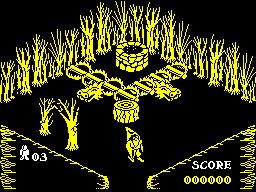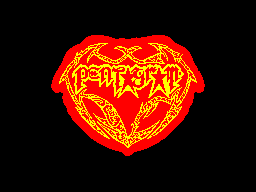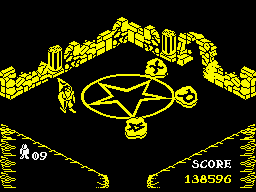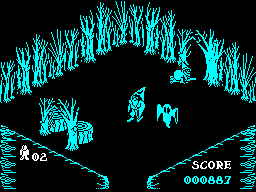.gif)
Pentagram (video game)
Encyclopedia
Pentagram is a ZX Spectrum
and MSX
video game released by Ultimate Play The Game
in 1986
. It is the fourth in the Sabreman series, following on from his adventures in Sabre Wulf
, Underwurlde
and Knight Lore
. Similarly to Knight Lore it uses the isometric
Filmation engine
. The game was written by either Tim and Chris Stamper
or a U.S. Gold
programming team (see the main article for the reason for this confusion).
 This was Ultimate's way of describing the object of the game, which is to recover the lost Pentagram
This was Ultimate's way of describing the object of the game, which is to recover the lost Pentagram
, an artefact of magical power. Firstly Sabreman must locate one of the wells
located in the maze of screens, shoot it several times with his spell and take the resultant bucket of water to one of the broken obelisks. When dropped on these, the water will "heal" the stone. This must be done with each of the four obelisks to make the titular Pentagram appear in one of the rooms. Once this is done, five magic runestones must be found and placed on the Pentagram itself.
 Though the objective in Pentagram is more complex and obscure than the simple "find and fetch" gameplay of the two previous Filmation
Though the objective in Pentagram is more complex and obscure than the simple "find and fetch" gameplay of the two previous Filmation
games Knight Lore
and Alien 8
, the gameplay is similar to those two titles. The main differences in this final revision of the Filmation engine are the new ability to shoot enemies with a projectile
magic spell, and the ability of the enemies to respawn. The "directional control" system of the previous games was also removed because the Spectrum's single joystick
button was now needed to fire Sabreman's spell, so could no longer be used to jump (instead, "down" on the joystick is used to jump).
 The basic gameplay is the same as that of Sabreman's previous outing Knight Lore (without that game's day/night transformation cycle), as he wanders a maze-like system of screens filled with enemies, pieces of movable scenery (often forming obstacles or puzzles), and exits on one or more walls, sometimes high up and difficult to reach.
The basic gameplay is the same as that of Sabreman's previous outing Knight Lore (without that game's day/night transformation cycle), as he wanders a maze-like system of screens filled with enemies, pieces of movable scenery (often forming obstacles or puzzles), and exits on one or more walls, sometimes high up and difficult to reach.
Pentagram features larger numbers of enemies than either Knight Lore or Alien 8, due to Sabreman's newfound ability to kill them. These include some new flying creatures, such as ghosts and lice, that don't kill Sabreman but get in his way (an idea reprised from Sabreman's second adventure Underwurlde
), and may even be jumped onto. These harmless but frequently annoying foes will gravitate toward Sabreman and hover around him disrupting his movement (and sometimes even nudging him off platforms) until they are destroyed.
 Others such as witches
Others such as witches
and zombies are lethal to touch but may be destroyed. These do not head straight for Sabreman, but wander in straight lines until meeting an obstruction, at which point they change direction. The same behaviour is true of the wood spiders, though these are more dangerous as they cannot be killed. The "Wulfsheads" are either static or move in a set pattern and also cannot be killed. When an enemy is destroyed by use of Sabreman's new magic fireball spell, another will drop in from the top of the screen to replace it after a short while, this happening much faster the further into the game the player progresses. There is a maximum of two enemies per screen at any one time, excluding any indestructible ones already in place when a room is entered. This is due to the limitations of the hardware which, as with the previous Filmation games, slows to a crawl when any more than four moving objects are on screen at once.
As with the previous two Filmation games, enemies may interact with scenery in a very basic way, shoving any movable objects (such as logs and tables) along when they bump into them. As before, Sabreman may also push one or more of these objects at once, though in Pentagram he may even move them from a distance with a blast of his magic.
and Gunfright
, are counted), and by that time other publishers were also releasing their own isometric Filmation-inspired games. Confusion was also a factor, with Your Sinclair
lamenting that Pentagram' s instructions were "shrouded in Ultimate's rather confusing 'poetry'," and Sinclair User
admitted that all they could work out of the objective was "it has something to do with the various wishing wells dotted about the game". Even CRASH
, who rated Pentagram very highly, hadn't quite worked out the game's objective at the time of review.
Review scores ranged from the 3/5 awarded by Sinclair User, who described it as "lazy" and criticised a perceived lack of imagination in the setting and design, to the 93% "CRASH Smash" awarded by the ever Ultimate-friendly CRASH
magazine, who cited the graphics, re-spawning enemies, and atmosphere as high-points.
ZX Spectrum
The ZX Spectrum is an 8-bit personal home computer released in the United Kingdom in 1982 by Sinclair Research Ltd...
and MSX
MSX
MSX was the name of a standardized home computer architecture in the 1980s conceived by Kazuhiko Nishi, then Vice-president at Microsoft Japan and Director at ASCII Corporation...
video game released by Ultimate Play The Game
Ultimate Play the Game
Ultimate Play The Game was a critically acclaimed video game developer of the early home computer era. "Ultimate Play The Game" was the trading name of Ashby Computers & Graphics Ltd. , a software company founded in 1982 by two ex-arcade game developers Tim and Chris Stamper...
in 1986
1986 in video gaming
-Events:-Notable releases:*Namco releases Sky Kid Deluxe, Hopping Mappy, Toy Pop, The Return of Ishtar, which is the sequel to Tower of Druaga, Genpei Tōma Den, and Rolling Thunder....
. It is the fourth in the Sabreman series, following on from his adventures in Sabre Wulf
Sabre Wulf
Sabre Wulf is a ZX Spectrum video game developed and released by Ultimate Play The Game in 1984. The game is the first in the Sabreman series. It was written originally by Tim Stamper and Chris Stamper, and later ported to many other computer platforms...
, Underwurlde
Underwurlde
Underwurlde is a video game for the ZX Spectrum and Commodore 64 developed and released by Ultimate Play The Game in 1984. The game is the second in the Sabreman series, following on from his adventures in Sabre Wulf. The format of the game is a 2D side view flip-screen platform game...
and Knight Lore
Knight Lore
Knight Lore is a computer game developed and released by Ultimate Play The Game in 1984. The game is the third in the Sabreman series, following on from his adventures in Sabre Wulf and Underwurlde. Unlike the earlier games in the series it used Ultimate's filmation engine to achieve a 3D look...
. Similarly to Knight Lore it uses the isometric
Isometric projection
Isometric projection is a method for visually representing three-dimensional objects in two dimensions in technical and engineering drawings...
Filmation engine
Filmation engine
Filmation is the trademark name of the isometric graphics engine employed in a series of games developed by Ultimate Play The Game during the 1980s, primarily on the 8-bit ZX Spectrum platform, but various titles also appeared on the BBC Micro, Amstrad CPC, MSX and Commodore 64 platforms.The...
. The game was written by either Tim and Chris Stamper
Tim and Chris Stamper
Tim and Chris Stamper are the co-founders of Ashby Computers & Graphics and later Rare...
or a U.S. Gold
U.S. Gold
U.S. Gold was a British video game publisher and developer from the early 1980s through the mid-1990s, producing numerous titles on a variety of 8-bit, 16-bit and 32-bit platforms.-History:...
programming team (see the main article for the reason for this confusion).
Introduction
Typically for an Ultimate release, the inlay card provides little actual instruction for playing the game, but includes a cryptic short story as an introduction.
Pentagram
A pentagram is the shape of a five-pointed star drawn with five straight strokes...
, an artefact of magical power. Firstly Sabreman must locate one of the wells
Water well
A water well is an excavation or structure created in the ground by digging, driving, boring or drilling to access groundwater in underground aquifers. The well water is drawn by an electric submersible pump, a trash pump, a vertical turbine pump, a handpump or a mechanical pump...
located in the maze of screens, shoot it several times with his spell and take the resultant bucket of water to one of the broken obelisks. When dropped on these, the water will "heal" the stone. This must be done with each of the four obelisks to make the titular Pentagram appear in one of the rooms. Once this is done, five magic runestones must be found and placed on the Pentagram itself.
Gameplay

Filmation engine
Filmation is the trademark name of the isometric graphics engine employed in a series of games developed by Ultimate Play The Game during the 1980s, primarily on the 8-bit ZX Spectrum platform, but various titles also appeared on the BBC Micro, Amstrad CPC, MSX and Commodore 64 platforms.The...
games Knight Lore
Knight Lore
Knight Lore is a computer game developed and released by Ultimate Play The Game in 1984. The game is the third in the Sabreman series, following on from his adventures in Sabre Wulf and Underwurlde. Unlike the earlier games in the series it used Ultimate's filmation engine to achieve a 3D look...
and Alien 8
Alien 8
Alien 8 is a ZX Spectrum video game. It was written by Tim Stamper and Chris Stamper of Ultimate Play The Game, and was released by the company in 1985. The game was also ported to the BBC Micro, Amstrad CPC and MSX platforms. It is the follow-up to Ultimate's Knight Lore, which had been released...
, the gameplay is similar to those two titles. The main differences in this final revision of the Filmation engine are the new ability to shoot enemies with a projectile
Projectile
A projectile is any object projected into space by the exertion of a force. Although a thrown baseball is technically a projectile too, the term more commonly refers to a weapon....
magic spell, and the ability of the enemies to respawn. The "directional control" system of the previous games was also removed because the Spectrum's single joystick
Joystick
A joystick is an input device consisting of a stick that pivots on a base and reports its angle or direction to the device it is controlling. Joysticks, also known as 'control columns', are the principal control in the cockpit of many civilian and military aircraft, either as a center stick or...
button was now needed to fire Sabreman's spell, so could no longer be used to jump (instead, "down" on the joystick is used to jump).

Pentagram features larger numbers of enemies than either Knight Lore or Alien 8, due to Sabreman's newfound ability to kill them. These include some new flying creatures, such as ghosts and lice, that don't kill Sabreman but get in his way (an idea reprised from Sabreman's second adventure Underwurlde
Underwurlde
Underwurlde is a video game for the ZX Spectrum and Commodore 64 developed and released by Ultimate Play The Game in 1984. The game is the second in the Sabreman series, following on from his adventures in Sabre Wulf. The format of the game is a 2D side view flip-screen platform game...
), and may even be jumped onto. These harmless but frequently annoying foes will gravitate toward Sabreman and hover around him disrupting his movement (and sometimes even nudging him off platforms) until they are destroyed.

European witchcraft
European Witchcraft is witchcraft and magic that is practised primarily in the locality of Europe.-Antiquity:Instances of persecution of witchcraft are documented from Classical Antiquity, paralleling evidence from the Ancient Near East and the Old Testament.In Ancient Greece, for example, Theoris,...
and zombies are lethal to touch but may be destroyed. These do not head straight for Sabreman, but wander in straight lines until meeting an obstruction, at which point they change direction. The same behaviour is true of the wood spiders, though these are more dangerous as they cannot be killed. The "Wulfsheads" are either static or move in a set pattern and also cannot be killed. When an enemy is destroyed by use of Sabreman's new magic fireball spell, another will drop in from the top of the screen to replace it after a short while, this happening much faster the further into the game the player progresses. There is a maximum of two enemies per screen at any one time, excluding any indestructible ones already in place when a room is entered. This is due to the limitations of the hardware which, as with the previous Filmation games, slows to a crawl when any more than four moving objects are on screen at once.
As with the previous two Filmation games, enemies may interact with scenery in a very basic way, shoving any movable objects (such as logs and tables) along when they bump into them. As before, Sabreman may also push one or more of these objects at once, though in Pentagram he may even move them from a distance with a blast of his magic.
Reception
In terms of gameplay and features Pentagram was the most advanced of the Filmation titles, but some sections of the gaming press were becoming tired of the concept and accused Ultimate of unoriginality. This was Ultimate's third Filmation title (fifth if the Filmation II games, NightshadeNightshade (video game)
Nightshade is a ZX Spectrum video game developed and released by Ultimate Play The Game in 1985. Building upon the earlier titles Knight Lore and Alien 8 using the flip-screen, isometric gameplay branded Filmation, Nightshade introduces a scrolling isometric environment branded Filmation II.-...
and Gunfright
Gunfright
Gunfright is a ZX Spectrum video game developed by Ultimate Play The Game for U.S. Gold in 1986. The game makes use of the same scrolling isometric projection engine used previously in Nightshade. The player takes the role of sheriff in the town of Black Rock. Some outlaws are headed into town...
, are counted), and by that time other publishers were also releasing their own isometric Filmation-inspired games. Confusion was also a factor, with Your Sinclair
Your Sinclair
Your Sinclair or YS as it was commonly abbreviated, was a British computer magazine for the Sinclair range of computers, mainly the ZX Spectrum.-History:...
lamenting that Pentagram
Sinclair User
Sinclair User, often abbreviated SU, was a magazine dedicated to the Sinclair Research range of home computers, most specifically the ZX Spectrum...
admitted that all they could work out of the objective was "it has something to do with the various wishing wells dotted about the game". Even CRASH
CRASH (magazine)
Crash was a magazine dedicated to the ZX Spectrum home computer. It was published from 1984 to 1991 by Newsfield Publications Ltd until their liquidation, and then until 1992 by Europress.-Development:...
, who rated Pentagram very highly, hadn't quite worked out the game's objective at the time of review.
Review scores ranged from the 3/5 awarded by Sinclair User, who described it as "lazy" and criticised a perceived lack of imagination in the setting and design, to the 93% "CRASH Smash" awarded by the ever Ultimate-friendly CRASH
CRASH (magazine)
Crash was a magazine dedicated to the ZX Spectrum home computer. It was published from 1984 to 1991 by Newsfield Publications Ltd until their liquidation, and then until 1992 by Europress.-Development:...
magazine, who cited the graphics, re-spawning enemies, and atmosphere as high-points.
External links
- Pentagram at Ultimate Wurlde
- Pentagram review at CRASH magazineCRASH (magazine)Crash was a magazine dedicated to the ZX Spectrum home computer. It was published from 1984 to 1991 by Newsfield Publications Ltd until their liquidation, and then until 1992 by Europress.-Development:...
- A walkthrough video of Pentagram on the ZX Spectrum

